What Causes A Pound Cake To Not Cook On Top
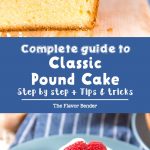
Classic Pound Cake – A consummate guide on how to brand perfect, and delicious Pound Cake! Tips + Tricks and Troubleshooting guide.
This is a comprehensive post with stride past footstep instructions on how to make a Classic Pound Cake!
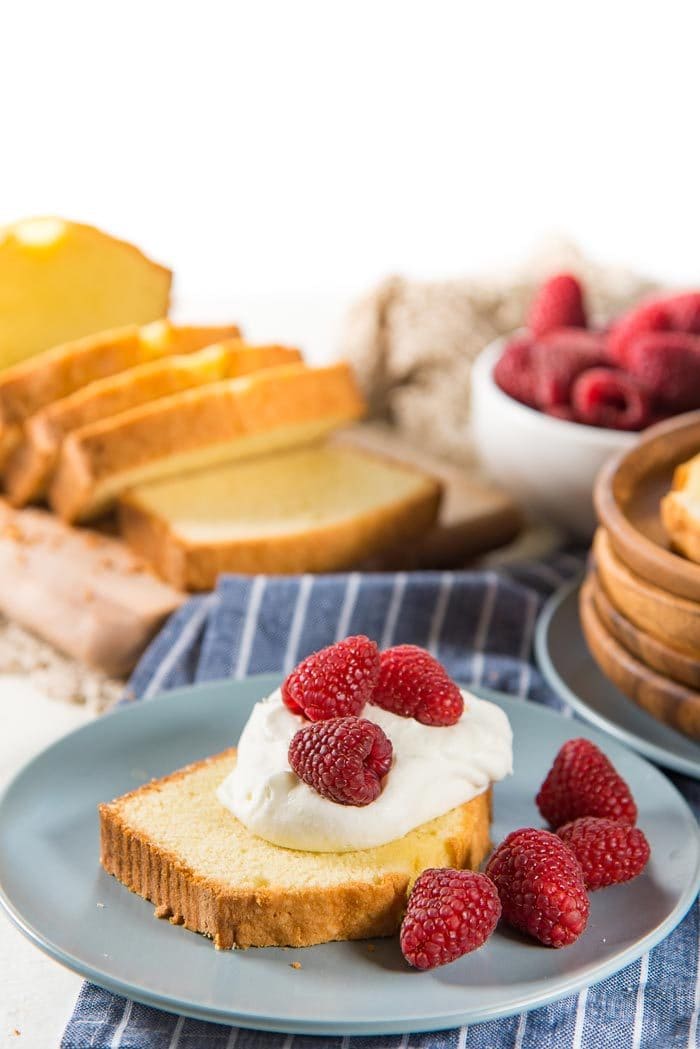
I'll be sharing tips and techniques, pound cake troubleshooting ideas equally well as cheat codes to help you brand perfect, moist pound cakes. This archetype pound block is then easy and fool-proof, you tin nail it fifty-fifty if y'all're a baking novice!
This is a long mail service, and so y'all can zip directly down to the recipe below if you similar. But if yous're looking for tips and tricks to PERFECT your pound block, then yous're in the correct identify!
So let's start at the start.
Why is it called a pound cake?
Pound cakes start originated in Europe. They've been around since every bit early as the 1700s, and the term traditionally referred to a cake that weighed four pounds. That'south because a classic pound block consisted of i pound of each of the following FOUR ingredients,
- Butter
- Sugar
- Eggs
- Flour
As yous tin discover, a archetype pound block doesn't rely on whatsoever leavening agents to requite the cake whatsoever lift, or any actress liquid to brand the cake moist. The result is a dumbo cake, that was also somewhat dry out (especially when over-baked).
As pound cakes have become more pop throughout history and throughout dissimilar parts of the world, different variations of the classic pound cake have emerged, that are lighter and more moist. Each region (or land) has their own version of a classic pound cake, incorporating different ratios of the main ingredients, and sometimes including extra liquid and baking powder too.
A moist pound block recipe was the first cake that I learned to bake likewise! 🙂 For this pound cake troubleshooting post, I baked all kinds of variations of a pound cake. You can see the results below, and I'll help you troubleshoot some common pound cake mistakes every bit well!

Tips to follow for the Best classic pound cake
Beginning with adept ingredients
Well, that's a given, but information technology's especially true with pound cakes. Rather than using generic ingredients, try and apply brand name ingredients.
Sugar
When it comes to sugar, make sure to get pikestaff saccharide because it has a finer grain than other white sugars (if information technology doesn't say cane sugar, then it'southward probably beet sugar). If y'all tin get your hands on pure cane caster sugar (super fine sugar) that's even better!
Butter
With butter, use a GOOD quality butter. Non margarine, not spreadable butter, simply classic butter. I prefer to use unsalted butter, but you tin use salted butter likewise. Even so, due to the higher h2o content in salted butter, there'south a higher chance for inconsistent results when using salted butter every bit well.
Eggs
Employ organic, free-range eggs whenever possible. However, avert using really fresh eggs. Shocker right?
I prefer to employ eggs that are about 1 calendar week former and hither's why. The egg whites in fresh eggs are tighter and thicker whereas in older eggs, the egg whites are thinner and looser. These older eggs mix into the cake batter more easily and readily, resulting in a pound cake that's lighter in mouthfeel and crumb texture. Another reason is that fresh eggs are heavier than older eggs – and so 8 fresh big eggs would be way heavier than one lb, while 8 older big eggs would exist closer to 1 lb.
Flour
I similar to use unbleached all purpose flour. This is because information technology is more than widely bachelor.
But you can besides use cake flour instead. This is lighter, and has less gluten than all purpose flour. Resulting in pound block that rises a little more than, and has a more tender crumb.
If y'all choose to go with pastry flour, you can substitute cake flour for AP flour at a ane:1 ratio – Past WEIGHT (not volume).
E'er WEIGH your ingredients, rather than relying on cups.
I am a HUGE advocate of using an inexpensive kitchen scale for all your baking needs. Baking does need some precision and a cheap weighing scale volition ensure consequent baking results every time, which volition save you and then much more time and money in the long run from failed recipes and wasted ingredients.
For example, when measuring flour with a cup, you can potentially get upwardly to l% more flour than you intended. OR, if you choose to use cake flour for your classic pound cake instead – 1 cup of cake flour is lighter than AP flour, so you volition cease up with LESS block flour than needed for your recipe if y'all apply a cup to measure.
When measuring sugar with a cup, 1 loving cup of regular saccharide will weigh LESS than 1 cup of super fine sugar. So once more, this is why a measuring scale would be actually handy. Or you could easily end up with a sickly sweet pound cake because of too much sugar.
If yous do employ cups nonetheless…
It'south important to fluff up the flour and sugar in the container, and and so scoop the flour and carbohydrate into the measuring loving cup to the point of overflowing. Then, using a flat pocketknife, level off the excess flour/sugar. Information technology would still exist difficult to guarantee consistent results this mode, nevertheless.
If you're living in the US, then ane stick of butter = iv oz / 115 g / or 0.5 cups. But for anywhere else in the world, the best thing would be to measure the butter as well using a measuring scale.
Temperature of ingredients
It's absolutely important that all the ingredients are at room temperature (70-75°F or xx – 23°C).
Butter
Butter should be softened, but not likewise softened. Here'southward a crude way of checking if your butter is at the right consistency – make an indentation in the butter with your finger. If the butter is besides hard to make an indentation, and so well, the butter is too hard. 🙂 But if the butter does make an indentation, but information technology doesn't keep its shape, and the butter effectually the indentation loses shape, then the butter is too soft (the butter can likewise be too oily when information technology'due south this soft). If it's easy to brand an indentation simply information technology besides keeps its shape without distorting any of the butter in the surrounding area, then it's at the correct consistency!
In the wintertime, I remove the butter from the fridge and keep information technology outside overnight. But in the summer, this could make the butter too soft. Then instead, in the summertime, I prefer to cut the butter into table spoon sized pieces and and then leave them out to soften for about 30 minutes or then. If the butter gets too soft, so you tin can but stick it back in the fridge for well-nigh 10-15 minutes to let them chill simply a little bit.
Room temperature butter creams and whips easily. This is of import considering the butter will incorporate air during creaming/whipping which is essential for a light pound cake. If it'southward too cold/hard, or too soft/melted, so it cannot concur air while beingness whipped.
Eggs
Eggs should also be kept outside overnight, and then that they are all at room temperature.This will help the eggs retain air also, while existence mixed.
Flour and sugar should likewise be at room temperature. I usually store flour and sugar at room temperature anyway, but if y'all store flour in the fridge, call back to remove it from the refrigerator the night earlier.
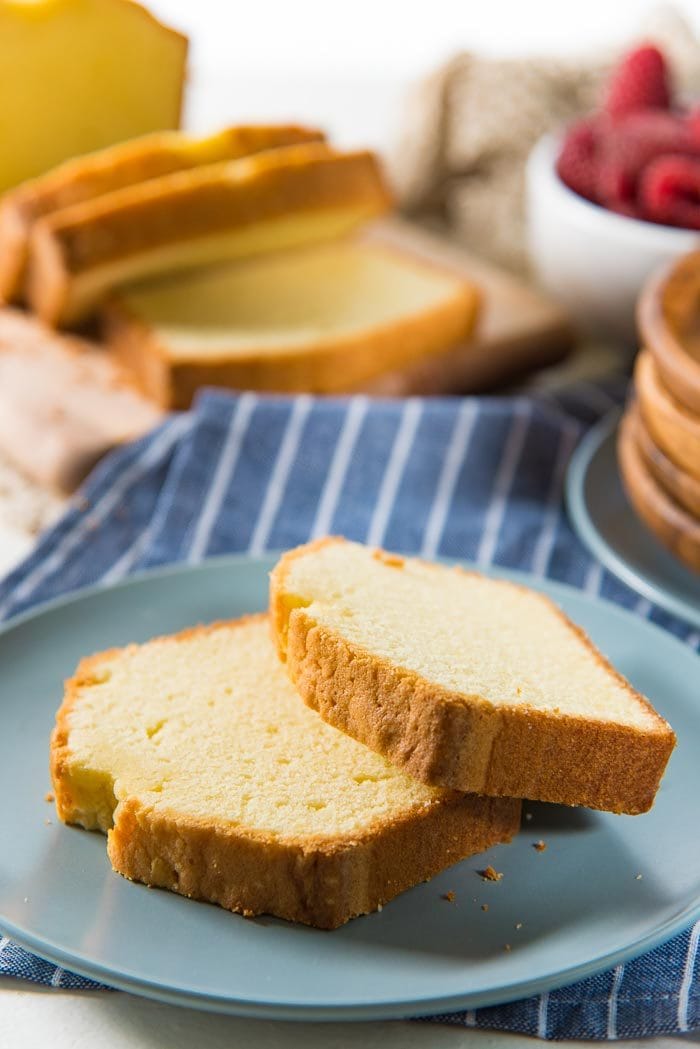
How to brand Pound block – Step past footstep.
Since a classic pound cake does not rely on baking pulverization or blistering soda for the cake to ascension, the process of mixing the ingredients is crucial. That'southward because this classic pound cake relies heavily on the air that is being incorporated during the mixing of butter and saccharide, which further gets trapped by the gluten and eggs during baking.
There are only FOUR STEPS for a classic pound cake – butter, adding saccharide, adding eggs, and adding flour. Each step is equally important. Make sure EACH INGREDIENT HAS BEEN WEIGHED and prepared (and sifted), Before you outset making the pound cake.
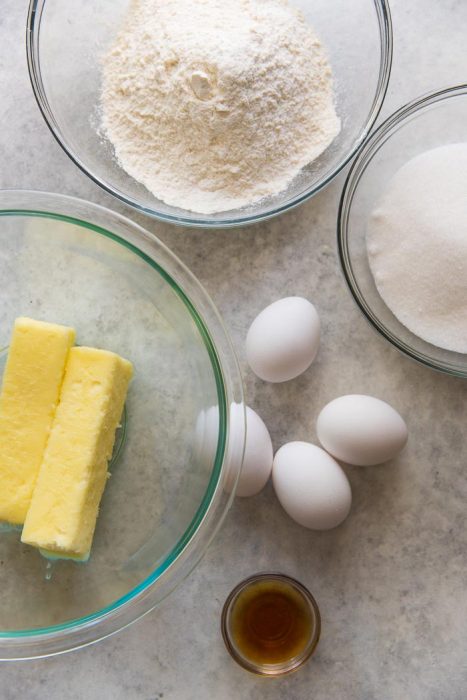
Stand mixer vs Hand mixer
I prefer to use a stand up mixer over a paw mixer for convenience. Yous need to cream the butter and sugar together for a few minutes to comprise the air, and trust me, your hands will thanks if you lot use a stand mixer instead of a hand mixer.
Creaming butter and sugar
The butter needs to be mixed for a few minutes (virtually 3 – vii minutes, depending on the room temp. and the butter temp.) by itself first. Utilise the standard mixer attachment in your mixer to do this (non the whip or the dough claw), and this volition ensure the incorporation of air in the butter, making it light, fluffy and creamy. Another fault to avert is running the stand up mixer at high speed to speed upward the process. Practice Not DO THIS! The loftier speed can knock the air out really fast. So run the mixer at medium speed to let the air in slowly but surely!

When the butter is fluffy, and then the sugar is added. Make certain not to dump all the sugar in at once. The weight of the sugar can crusade the butter to deflate, which is NOT expert. And then add together the carbohydrate in a thin, steady stream, while the stand mixer is running. This volition help cream the butter and sugar together, evenly, adding more air, rather than knocking out the air.
The butter and sugar are creamed together for a few minutes as well. This is for 2 reasons – one, to incorporate more air and two, to deliquesce the saccharide. This is why I prefer to use pulley sugar which dissolves much faster. The saccharide may not need to exist completely dissolved earlier the addition of the eggs, only they definitely should be completely dissolved later you add the eggs. If you're using regular cane sugar, you lot can whiz the saccharide separately in a nutrient processor for a few seconds to brand information technology finer, if you similar.

Calculation eggs
The next of import footstep is the addition of eggs.The aforementioned principle as earlier of not weighing downward the batter by adding all the eggs in at once, applies here likewise. There are TWO means to achieve this,
- Lightly whisk all the eggs in a jug, and and so add the eggs slowly in a stream, with a few breaks in between.
- Add the eggs ane at a time, mixing each one well before adding the next.
Both techniques work, but for convenience, I usually go with the second method. I always crack an egg into a small basin first, and add it while the stand mixer is running. I mix in the eggs for about 20 – 30 seconds, until the yolk has disappeared, and then I add the adjacent egg.
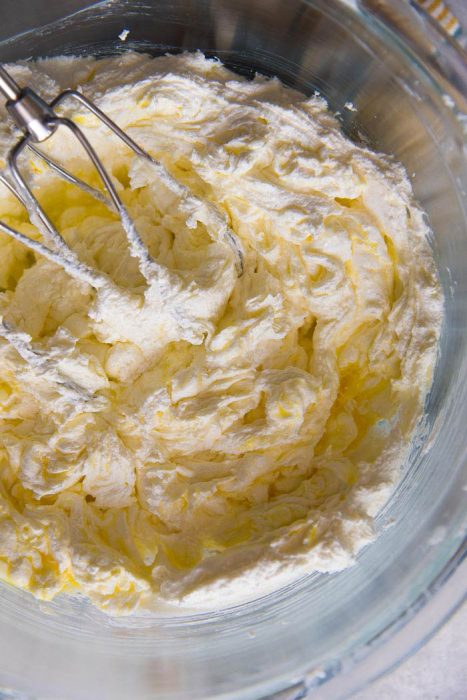
It's important to non let the eggs over-vanquish in the batter as well. If yous over-beat the eggs, the block Volition Collapse Later BAKING!
Some recipes call for more egg yolks, instead of using whole eggs only. Y'all Can SUBSTITUTE TWO WHOLE EGGS, with FOUR YOLKS IF Yous PREFER. This will effect in a cake that is richer in gustatory modality and more than moist. The block will have a richer yellow color as well.
But remember that egg whites add together lift to the cake, while egg yolks add richness. The reason why some prefer to add egg yolks is because egg whites, while adding volume and lift to the cake, can too dry out the block.
Cheat Annotation 1 – Instead of two of the whole eggs in the recipe, add four egg yolks to become a more than moist and richer tasting pound block.
CHEAT NOTE two – I would too add 1 tsp of blistering powder IF I substitute 2 eggs with FOUR EGG YOLKS. This is to compensate for the lack of egg whites.
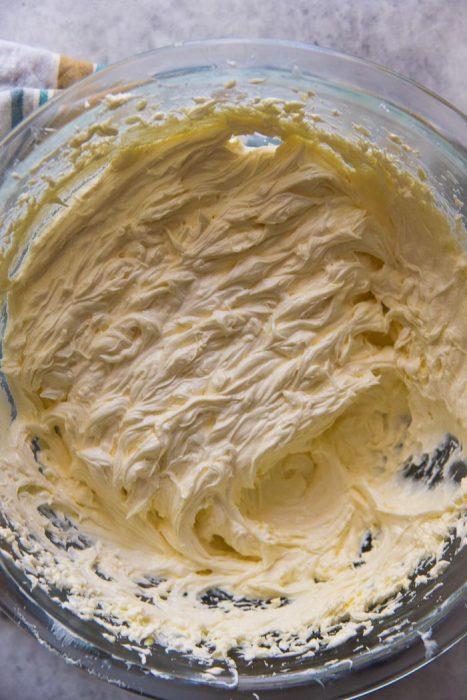
Incorporating flour
Make sure the flour is sifted earlier you add together information technology to the block. It's even better if you tin can sift it AGAIN when you're adding it to the block, but that's not necessary. This is to reduce the likelihood of flour lumps forming when mixing the flour.

If you're able to incorporate the flour with a blistering spatula – Exercise IT! Folding in the flour past mitt (spoon), will make certain that you don't overwork the gluten in the flour.
If you exercise apply your stand mixer, utilize the lowest speed on the stand up mixer, and utilize it for the smallest corporeality of time.
If the gluten is over-worked, you volition end up with a tougher and dense pound cake, NOT expert. Another way to avoid this is to use cake flour instead of AP flour.

Cheat NOTE – Cake FLOUR tin exist substituted for AP flour considering it'll give a lighter texture to your pound cake. This will make your cake rise more than in the oven also.
Crook NOTE – If y'all're worried that your block wasn't browbeaten enough, yous Can add just the smallest amount of blistering powder to make sure your pound cake rises properly. I ONLY exercise this if I apply a hand mixer to mix my pound block batter, considering I know that and so there's a run a risk that I may not have incorporated enough air.
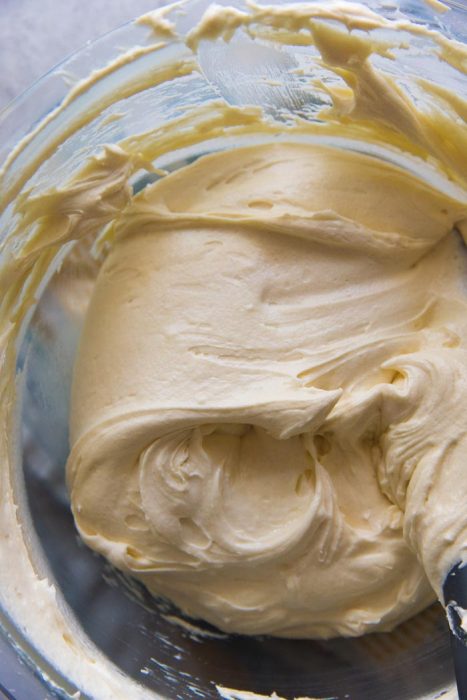
Blistering the Block
Authentic OVEN TEMPERATURE is important.It'll be great if you know that your oven is properly calibrated. You can exercise this past placing an oven temp. reader in your oven, and and so comparing the temp. displayed on your oven with that of the reader. If by take chances your oven is not calibrated, you tin can adjust the baking temp. based on how your pound cake turns out on the first endeavor.
If the cake is also dry, and then the oven is also hot, and y'all may need to lower the temp. OR remove the cake from the oven earlier. If the block is not done by 70 minutes, and then the oven temp. needs to be increased, or the cake needs to bake longer.
Also make sure to PREHEAT THE OVEN for a adept 10 – 15 minutes before putting your block in.This style a stable oven temp. is guaranteed.
Your baking pans tin accept an issue on the baking times besides. If you utilize glass cake pans or dark metal pans, the baking time will shorten. If y'all're using a light baking pan, so this recipe volition exist accurate, considering I used a light baking pan equally well.
I used two 8.v ten 4.5 inch loaf pans for this archetype pound cake recipe. You tin arrange this to make the cake in two 9.5 10 5.v inch loaf pans, but be mindful to bank check on the cake before, as it volition bake faster.

The last result is an incredibly buttery, soft, classic pound cake! The crumb is tight and together, only non dense or gluey – information technology's buttery and soft and merely so addictively succulent!

Classic Pound Cake serving ideas
You tin can enjoy this classic pound cake in And so MANY different ways! Serve it as is, or acme it with various additions to make simple but delicious desserts. Bank check out these creative ways to serve this classic moist pound cake.
- Berries and foam (raspberries, strawberries, blueberries or whatever other type of berry)
- Assistant and butterscotch sauce – this would taste similar bananas foster, but with block!
- Chocolate sauce or hazelnut chocolate spread! Who doesn't honey cake and chocolate (or Nutella) together?
- Whipped cream and nuts or praline – to enhance the nutty flavor even more, you lot can flavor your cake with nut flavoring besides (almond, toasted coconut, pistachios, or peanuts)
- Lemon glaze or lemon curd – a refreshing and tangy twist to your buttery pound cake! Either cover the cake with lemon glaze or pour it over cake slices. Alternatively, y'all can serve information technology with lemon curd or whatever kind of citrus curd.
- Whipped cream and Kahlua – THIS IS MY FAVORITE! Information technology tastes like tiramisu! A shot of kahlua (or any other sweet liqueur that you like) poured over a cake piece, and so topped with whipped foam or ice foam. An irresistible choice for the adults!

Other options not pictured here,
- Grill the pound cake slices (peculiarly if y'all have dried pound cake), and serve them warm with grilled fruits and ice cream.
- Cut the block into cubes and add them in trifles!
- Cutting into cubes, and then lightly toast them, and add them into fruit salads – they'll be similar dessert croutons!
- Make ice cream sandwiches with the pound cake.
Making a classic pound cake is a rewarding experience! 🙂 I hope this lengthy post helped you empathise how a classic moist pound cake comes together and why each footstep is of import. It'll assist you lot master the fine art of making classic pound cakes and and so add your own personal touch to make the recipe even more versatile!
Back to Elevation
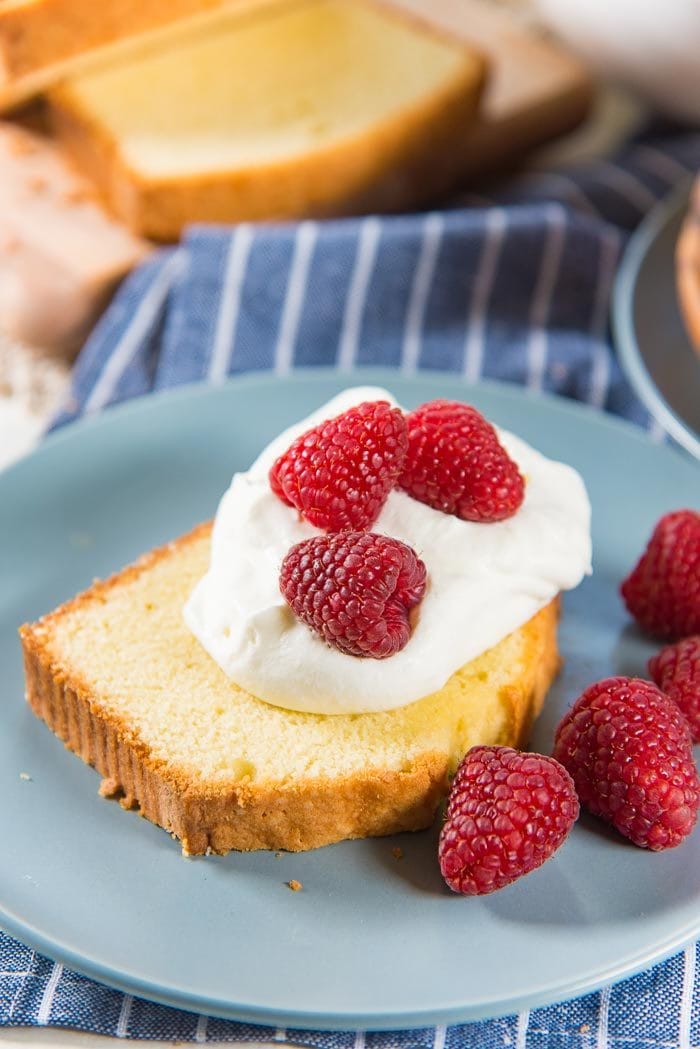
Pound cake comparisons
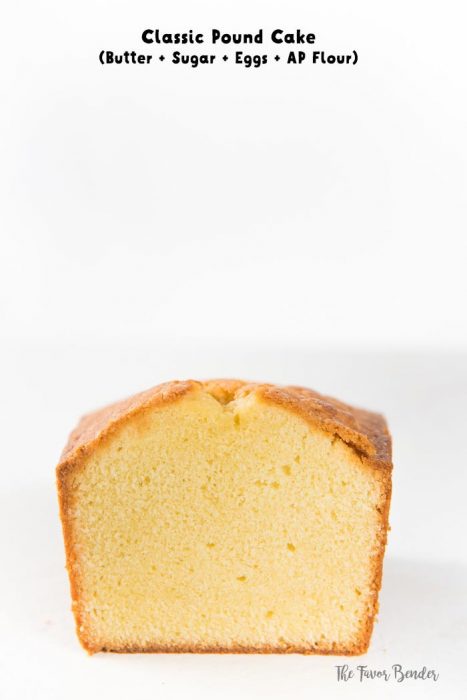
Pound block troubleshooting
Why is my cake so dense and heavy?
Chances are not enough air was incorporated into the butter and saccharide. This could exist because the creaming time wasn't long enough, or because the saccharide, eggs or flour were incorporated too quickly.
Solution – cream the butter until fluffy, so incorporate the sugar in a thin stream. Add the eggs one by 1, or in a stream. Add together the flour in batches.
The gluten in the flour was overworked, causing the gluten to make the cake likewise heavy and too dense. Employ minimal force to incorporate the flour.
Solution – Preferably, fold in the flour in batches using a spatula, or use the absolute shortest time with your stand mixer to mix in the flour on the lowest speed.
Brand certain the flour is fully incorporated too – because dry flour streaks tin can result in a mucilaginous pound block.
Use cake flour instead of AP flour.
Why is my pound cake dumbo and actually dry?
Pound cake is SUPPOSED to be a little dumbo. Just it's not supposed to feel heavy or dry. If it's dry out, the cake may take been over-baked. The cake tin can likewise be too dry if y'all added too much flour (or not enough butter or carbohydrate).
Solution –
You can try lowering the oven temperature.
Or remove the block from the oven a little earlier.
Or follow the recipe exactly – and refrain from calculation extra flour or reducing the amount of carbohydrate or butter.
Why does my pound cake accept a very tough crust?
This usually happens because the oven temperature is also loftier. Then the crust cooks a lot faster than the inside of the cake, creating a tough crust and a soft middle.
Solution –
Lower the temperature of the oven and cook the pound cake for longer.
Using a light colored loaf pan instead of a dark loaf pan likewise helps.
Why does my pound cake have viscous streaks?
The butter and sugar were creamed too fast and too much! The cake rises, so collapses while cooling, causing the cake to have dumbo, gummy (or pasty) spots.
Solution –
DON'T increase the speed of your mixer beyond medium speed. And lower the speed to the everyman setting when adding in the flour (or fold in the flour by manus).
My pound cake chaff separated from my block later baking
If you over-beat the eggs, the air in the eggs will cause the cake to rise. Information technology will create a chaff that will rising college than the cake (the same way that eggs can create a crust in brownies, they can create a crust in cakes as well). However, since the rest of the cake did not rise every bit much (since there is no baking powder etc), the chaff volition fall as the cake cools downwardly, creating a wrinkled cake crust.
Solution –
Make certain to simply beat the eggs to the point of incorporating the eggs. If you beat each egg for more than a infinitesimal each time, you may encounter this issue.
My pound cake crust has little spots on it
These are sugar crystals. As the cake is baking, the unmelted sugar crystals melt with the heat of the oven, causing piffling spots to appear on the cake crust.
Solution –
Utilize cane sugar that's a little finer than granulated white sugar.
Pulley sugar is even better (super fine saccharide – Non confectioner'south sugar)
If you can't discover caster sugar, you can process the sugar for a few seconds (a few pulses) in your food processor to plough them super fine. If you're using measuring cups, make sure to WEIGH THE Sugar FIRST earlier putting information technology through the food processor (super fine sugar measures differently than granulated sugar when using cups)
My pound block sunk in the eye
This classic pound cake should non sink in the middle, unless the block was under-baked or extra liquid was added.
Solution –
If you're using salted butter, try the cake with unsalted butter, and eliminate all other extra liquids (if y'all added milk for case)
Bake the block for longer.
My block overflowed from the cake pan (8 x 4 inch loaf pan)
If you over-beat the eggs, or beat out the butter and sugar too fast, or added besides much baking powder, the cake tin can ascension as well much and flow over the edges of the pan.
Solution –
Reduce the mixing time and don't use high speed to mix the ingredients.
If you adopt to employ baking powder, consider using a 9 x 5 inch loaf pan, instead of a 8 x 4 inch loaf pan.
If you liked this recipe, yous may likewise like,
Perfect Vanilla Cake
Swirled Pastel Easter Cake
Classic Chocolate Cake
Fudgy Ane Bowl Chocolate Sheet Block
Lemon Raspberry Cake
Super Like shooting fish in a barrel Chocolate Molten Cakes
Sign upwardly for my free recipe newsletter to get new recipes in your inbox each week! Find me sharing more inspiration on Pinterest and Instagram.
Prep: 35 minutes
Cooling in Pan: 15 minutes
Cook: one hour 10 minutes
Total Time: 1 hour 45 minutes
Servings: servings
- 1 lb unsalted butter softened at room temperature (4 sticks of butter)
- ½ tsp fine sea salt
- 1 lb cane sugar or pulley sugar (nearly 2 ¼ cups)
- viii big eggs ane lb of eggs, with shell on
- 14 oz AP flour or cake flour roughly 3 ¼ cups AP flour
- ane tsp blistering powder (optional)
- 2 tsp skillful quality vanilla extract you can add together almond extract, or whatsoever other flavor extract you adopt
-
Butter ii viii.v x four.5 inch loaf pans, and dust the inside of the pans with flour to glaze. Shake off excess flour. Set aside.
-
Preheat oven to 325°F/170°C.
-
Weigh out all the ingredients and go on them close at manus. Sift the flour and set aside in a bowl.
-
Optional step – if you lot're using granulated cane sugar, place the sugar in a nutrient processor and pulse a few times to go a effectively carbohydrate texture.
-
Remove the mixing basin from the weighing scale and place information technology in your stand up mixer with the beater zipper attached.
-
Identify the softened butter and salt in the bowl and cream the butter until light, creamy and fluffy (between iii – vii minutes), at medium speed (speed 4 – 5 on a kitchen aid mixer). Scrape the sides and bottom of the bowl to make sure you collect all of the butter.
-
Add the saccharide in a sparse, steady stream WHILE the butter is being mixed (you can also add the sugar tablespoon at a time likewise). Information technology should take approximately i min to contain the carbohydrate into the butter. Stop the mixer and scrape the sides and bottom of the bowl to ensure that the sugar is evenly mixed.
-
Foam the butter and sugar for a further 2 – iii minutes.
-
Suspension an egg into a small bowl, and brand certain there are no egg shells. Break the egg yolk, and and then pour the egg in a stream into the butter-sugar mix. Mix for most 20 – 30 seconds until the egg has incorporated into the batter, and in that location are no traces of egg yolk. Repeat with some other egg. After 2 eggs have been mixed into the batter, stop the mixer and scrape the sides and the bottom of the bowl.
-
Echo with the rest of the eggs, making sure to scrape the sides and bottom equally yous go (I do this afterwards every two eggs that I add).
-
When all the eggs have been added, add the vanilla and mix for a further 30 sec – ane minute.
Mixing in the flour past mitt – You will demand a long-handled blistering spatula to fold the flour into the batter
-
Stop the mixer and remove the mixing bowl from the stand mixer. Sift about ¼ of the flour over the batter. Fold the flour into the concoction, while rotating the bowl afterward each fold, until the flour is simply incorporated. Echo 3 more times with the remaining flour, and then that you carefully incorporate all of the flour while folding it into the batter (rather than vigorous mixing). This volition give you a smooth cake batter.
-
Brand sure at that place are no dry $.25 of flour in your batter.
Mixing in the flour with a stand mixer
-
Reduce the speed of the stand up mixer to the lowest setting (stir speed in a kitchen aid mixer).
-
Add ¼ of the sifted flour into the batter, and mix for a few seconds until but incorporated. Repeat with 3 more additions. Later the final addition, only mix the batter until you lot have a smooth batter. Finish immediately.
Baking the pound cakes
-
Add an equal amount of the batter to the bottom of each loaf pan. Using an start spatula, spread the batter evenly to the corners of the pan. Add together the rest of the batter (equally divided between the ii loaf pans) to the two loaf pans. Evenly spread on superlative to have an even surface. Gently shake the pans (merely a fiddling) to brand sure the concoction is evenly spread (don't knock the cake pans on the counter!).
-
Transfer the loaf pans into the oven (ideally in the lower tertiary of the oven, and correct in the center of the oven rack). Set the timer for 40 minutes. After 40 minutes, rotate the cake pans, and broil for a further 20 minutes.
-
Check the cake subsequently a total of threescore minutes of bake time to test the done-ness of the cake with a make clean toothpick or a cake tester. Insert the block tester into the cake, and if it comes out clean, and then the cake is washed. In my oven, these cakes accept well-nigh 67 – 70 minutes to bake.
-
Remove the cakes from the oven, and allow them to cool down for most 10 – fifteen minutes. Carefully turn thee cakes out onto a cooling wire rack to cool downward completely.
-
Eat warm, or at room temperature.
How to store Pound Cake
-
When the cake is at room temperature, it can be wrapped well with plastic wrap, and stored in an airtight container, and be consumed within a week. If the block isn't wrapped properly, it can become dried, But stale pound block will taste even better when toasted or grilled.
-
OR you tin wrap the cake in plastic wrap, and foil, and then stored in the freezer for upwards to 3 months.
OPTIONAL STEPS TO ENSURE THAT Yous Split up THE Concoction EVENLY BETWEEN TWO PANS
- Right at the start, BEFORE adding butter into the mixing bowl – place the empty mixing bowl on a weighing scale and note the weight of the basin (this is optional, but helps to evenly distribute the cake batter betwixt the pans afterwards).
- When the cake batter is fabricated, scrape any batter off of the spatula and remove the spatula from the basin. And then measure the weight of the bowl + concoction, and subtract the weight of the bowl from the value. This is the weight of the batter. Divide this value by two, and this will be how much you lot should add to each loaf pan (this further helps become PERFECT, evenly baked pound cakes).
Using different sized pans
- If you're using 2 nine.5 inch x 5.5 inch pans, check on the cakes afterwards 45 – l minutes. This is considering this cake can cook much faster in these bigger pans.
- Bundt block pan – this recipe is enough for 1 large bundt cake. Keep an eye on the cake after 50 minutes of baking time.
CHEAT Note –Instead of ii of the eggs in the recipe, add together four egg yolks to get a more moist and richer tasting pound cake.
CHEAT Notation –I would add 1 tsp of blistering powder IF I substituted 2 eggs with FOUR EGG YOLKS.
CHEAT NOTE – CAKE FLOUR tin can be substituted for AP flour because it'll give a lighter texture to your pound cake. But this will make your block rise more than in the oven too.
CHEAT NOTE – If you're worried that your block wasn't browbeaten enough, yous Tin add simply the smallest amount of baking powder to make sure your pound cake rises properly. I Merely do this if I use a mitt mixer to mix my pound block concoction, because I know then there's a gamble that I may not have incorporated plenty air.
Calories: 300 kcal (15%) Carbohydrates: 34 g (11%) Protein: 4 g (8%) Fat: 18 yard (28%) Saturated Fat: xi g (69%) Cholesterol: 103 mg (34%) Sodium: 78 mg (3%) Potassium: 46 mg (1%) Sugar: xx g (22%) Vitamin A: 600 IU (12%) Calcium: 17 mg (two%) Iron: 1.ane mg (6%)
"This website provides approximate nutrition information for convenience and every bit a courtesy only. Nutrition data is gathered primarily from the USDA Food Composition Database, whenever available, or otherwise other online calculators."
If you love cake, and so yous will absolutely beloved my new cookbook Undercover Layer Cakes!
If you don't have a copy, then you really really should go 1 Now! 🙂 That is, if you like combining a fantastic array of delicious flavors and textures and dissimilar types of dessert into outrageously inventive cakes (that's where the idea of hush-hush layers comes from!), that are besides surprisingly easy. In that location are threescore recipes in the book for cheesecakes, no bake cakes, water ice cream cakes and all types of dessert mash ups, like this Fudgy S'mores Brownie Pie here.
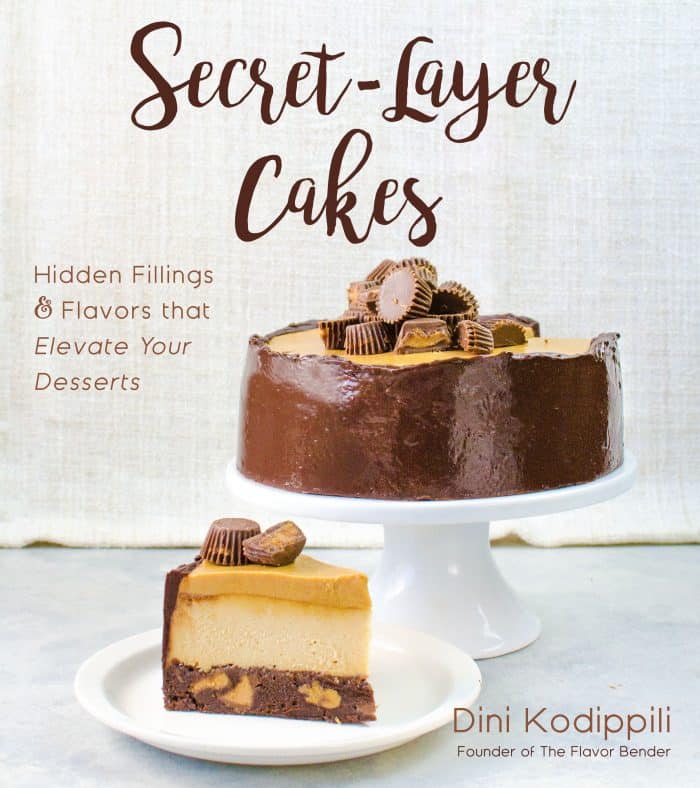
What Causes A Pound Cake To Not Cook On Top,
Source: https://www.theflavorbender.com/classic-pound-cake-guide-troubleshooting/#:~:text=This%20usually%20happens%20because%20the,crust%20and%20a%20soft%20middle.&text=Lower%20the%20temperature%20of%20the,the%20pound%20cake%20for%20longer.
Posted by: keeseefourning.blogspot.com


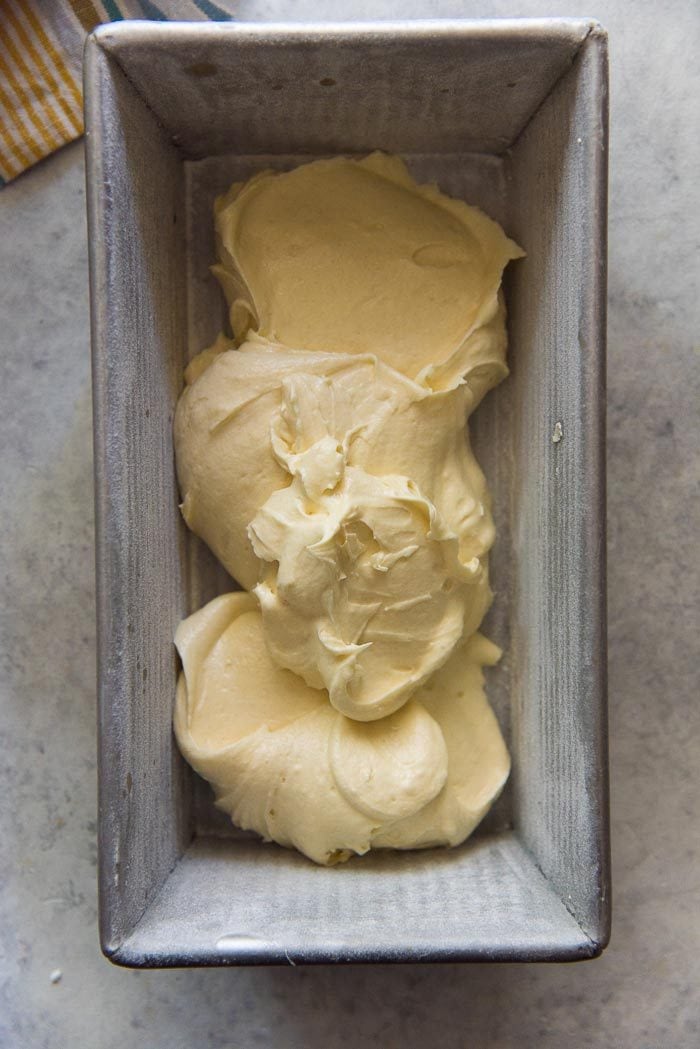



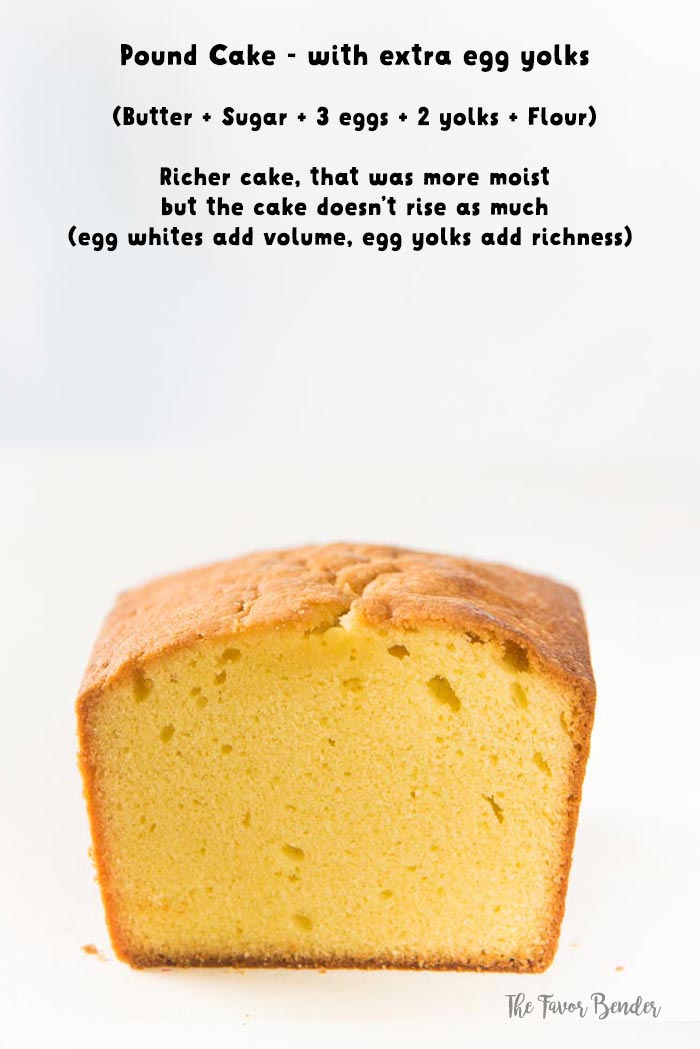

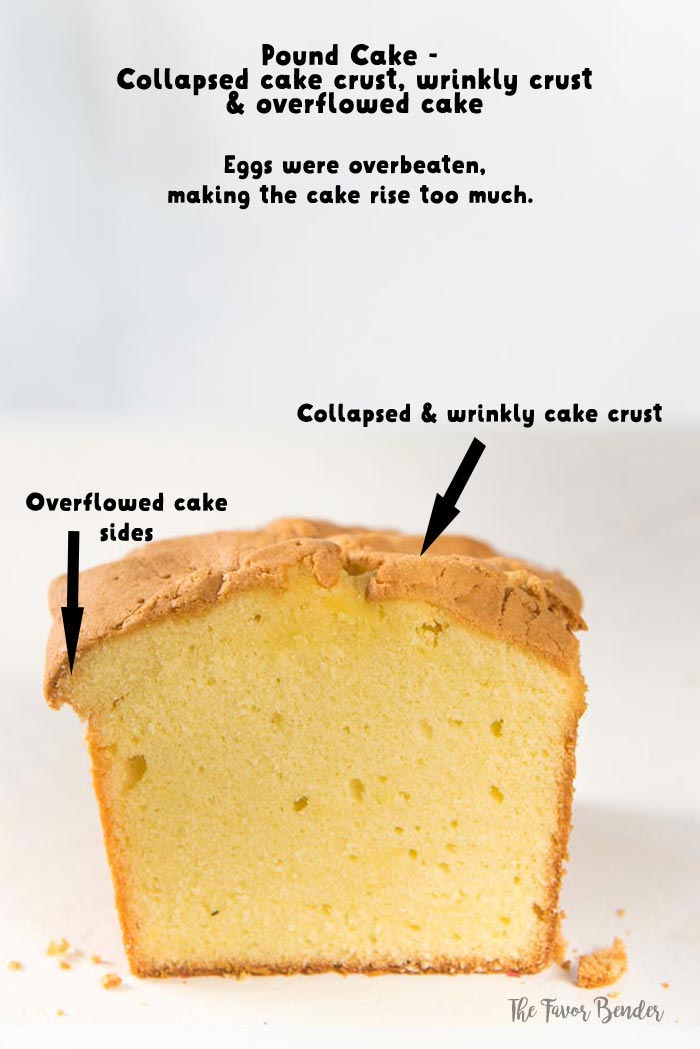

0 Response to "What Causes A Pound Cake To Not Cook On Top"
Post a Comment